Meet the Couple Spending Millions to Save California’s Architectural Gems
John McIlwee and Bill Damaschke’s collection has included the Lautner-designed Garcia House in Los Angeles and the former Rancho Mirage estate of Gerald and Betty Ford
John McIlwee and Bill Damaschke’s collection has included the Lautner-designed Garcia House in Los Angeles and the former Rancho Mirage estate of Gerald and Betty Ford
As a Capricorn, John McIlwee considers himself a spiritual person. But when his psychic told him in late 2021 that he was going to buy another house, he didn’t believe it. McIlwee and his husband, entertainment executive Bill Damaschke, already owned a portfolio of three architecturally significant California homes, and they’d decided not to take on any more projects.
“I said, ‘Hell, no. You’re wrong on this one,’” recalled McIlwee, 56, a Hollywood business manager.
Two days later, they’d signed a contract to buy a circa-1960s house in Rancho Mirage, roughly 10 miles from Palm Springs.
Sometimes, McIlwee just can’t help himself. The idea that someone might tear down or alter a beautiful old house is more than he can bear. In the case of the low-slung Rancho Mirage home, he couldn’t stand the thought that a developer might destroy it.
“I know myself,” he said. “If I let that house fall into the wrong hands and get ruined, it would piss me off every time I drove by.”
Over the past few decades, McIlwee and Damaschke, 59, have purchased and restored multiple houses, including former President Gerald Ford’s onetime estate and John Lautner’s Garcia House, an almond-shape structure considered one of L.A.’s most significant midcentury houses. McIlwee and Damaschke typically hold their houses long term and live in them, hosting parties and sometimes allowing commercial photo shoots.
“We’re living in a world now that is unsustainable with what people are destroying,” McIlwee said. “I didn’t particularly sign up to be some weird preservationist, but I look at these things as kind of like a mark in history.”
The couple admire how billionaire grocery tycoon Ron Burkle has restored a number of important trophy homes across California, McIlwee said. In comparison, he said he and Damaschke might be considered “Ron Burkle Light.”
“Ron’s doing the $50 million things,” he said. “We’re doing the $10 million things.”
McIlwee, a California native, serves as business manager to celebrities such as “The Batman” director Matt Reeves and “Glee” star Jane Lynch. Damaschke grew up in Chicago, where he admired the local Frank Lloyd Wright houses and took high school drafting classes. He originally harbored notions of becoming an architect himself, but eventually wound up in the theater, working as a Broadway actor and later transitioning to the business side of the L.A. entertainment world. He is now president of Warner Bros. Pictures Animation, and is also a producer of Broadway shows such as “The Prom” and “Moulin Rouge,” for which he won a Tony Award in 2021.
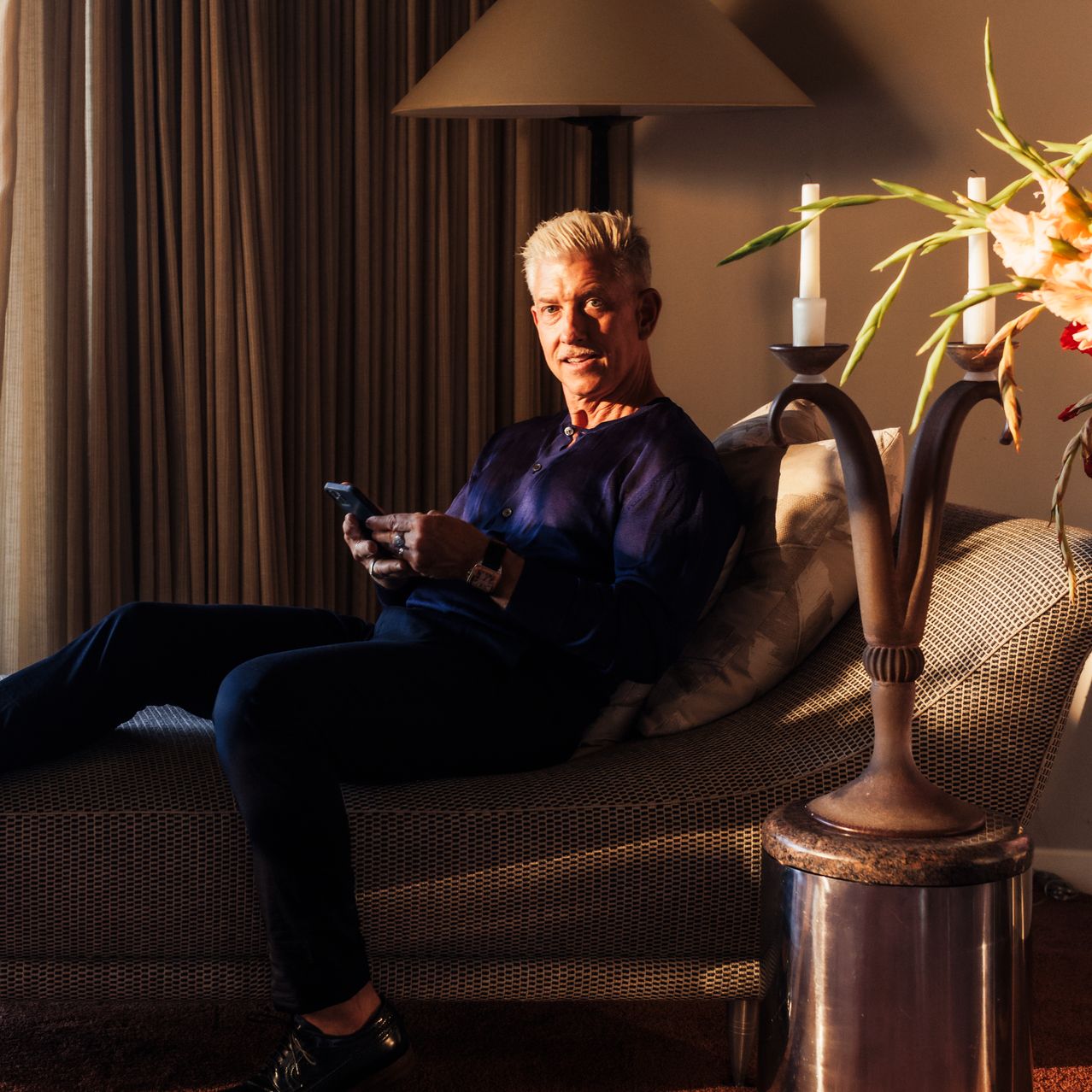
When it comes to their homes, the two said they typically work with the same “rat pack” of professionals, including landscape architect John Sharp, interior designer Darren Brown and architecture firm Marmol Radziner. McIlwee also sets up Instagram accounts for all the homes, posting historic photos and images from their parties and photo shoots.
“They are consummate cheerleaders for their houses,” said Leo Marmol, a California architect who has helped the pair restore several homes. “Their goal is not to pour liquid amber over a historic object to kind of freeze it. It’s the opposite. It’s to invite the world in to celebrate the home.”
McIlwee said he handles most of the logistics and the execution of their projects, while Damaschke is more of a creative thinker and would spend more money if McIlwee didn’t rein him in. Though he doesn’t consider the homes as investments so much as passion projects, “I never want to lose money,” he said.
The pair mostly agree about design choices, with a few exceptions.
“Sometimes we have huge screaming fights and don’t agree on anything,” Damaschke said with a laugh. “But we end up in a good place.”
One of Damaschke’s pet peeves: McIlwee is “classic California” and leaves all the windows and doors of their homes open. “Sometimes I’ll walk through and close the shades or drapes. He’ll come right behind me and open every one of them up after I leave the room.”
Read on for a closer look at the couple’s collection.
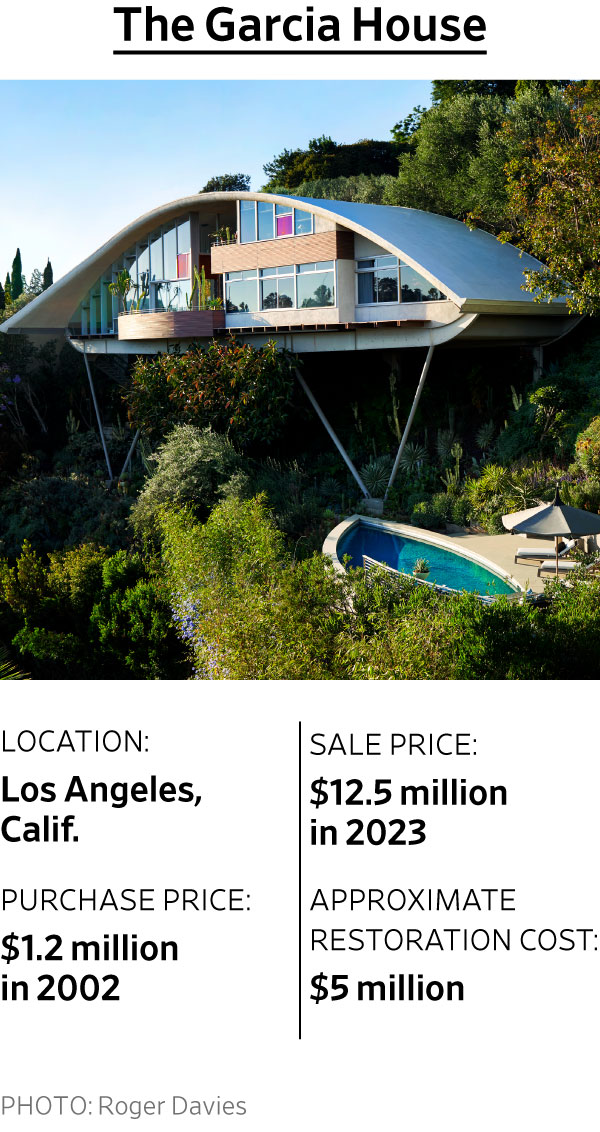
The couple’s primary residence for roughly 20 years was the Lautner-designed Garcia House, which sits 60 feet off the ground on concrete caissons. Dating to the 1960s, the three-bedroom home is perhaps best known for its star turn in the 1989 movie “Lethal Weapon 2,” where it appeared as the headquarters for a South African drug-smuggling cartel. McIlwee and Damaschke bought the roughly 2,600-square-foot house for $1.2 million in 2002, property records show.
When it comes to architecture, Damaschke said he’s often fascinated by the narrative behind a home, which was the case here. The original owners, film composer and conductor Russell Garcia and his wife, Gina Garcia, “were real trailblazers,” he said, “because the house was unbuildable. The lot was unbuildable. So, I’m like, ‘What possessed these people to build this amazing structure against the tide of what was popular at the time?”
After living in the property for more than a year to get a feel for the space, McIlwee and Damaschke embarked on a roughly $5 million restoration project at the house, which had fallen into disrepair. They also added an ellipse-shaped pool based on Lautner’s original plans.
Living in the house forced them outside, Damaschke said, since getting from the bedrooms to the main living room requires taking an external staircase. “The flow of it actually invited you to be a part of nature,” he said.
However, “it can be overwhelming, like you’re living in an art piece,” he said. “So we worked hard to make it super cozy and comfortable, like a home.”
Damaschke also called it “the best party house in the world.” The pair hosted numerous parties there, including one for the whole cast of “Moulin Rouge.”
After years in the house, the couple was ready to move on to their next adventure, they said. Earlier this year, the couple sold it for $12.5 million to Nicholas C. Pritzker, a member of the famed Pritzker hotel family.
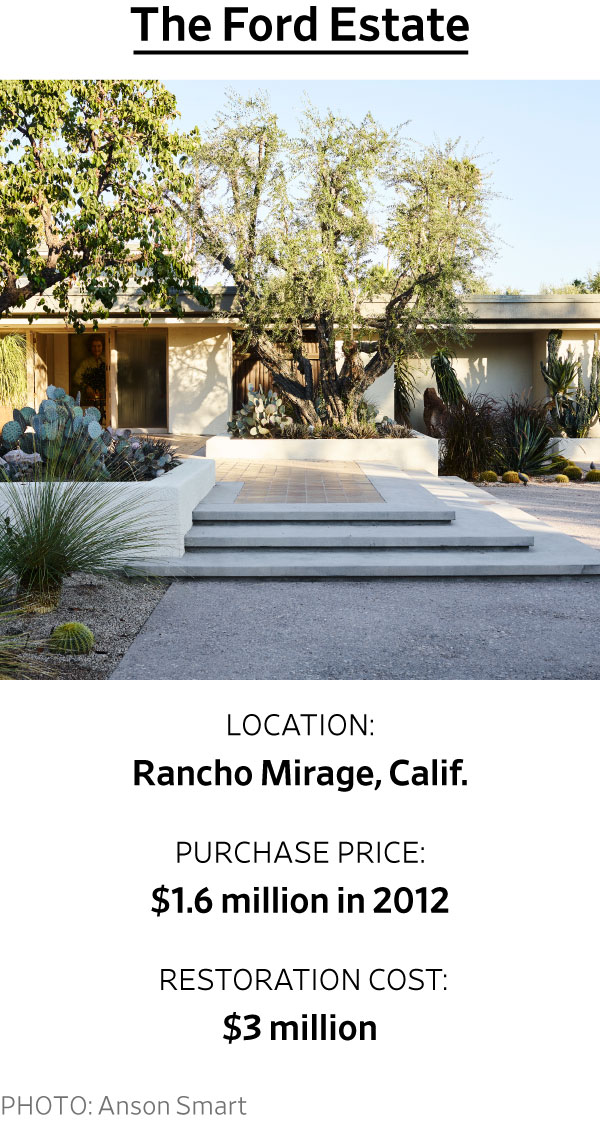
The Ford Estate in Rancho Mirage was designed in the 1970s for Gerald and Betty Ford after they left the White House. Located less than 2 miles from the Betty Ford Center, the rehabilitation center founded by the former first lady, the roughly 6,300-square-foot, five-bedroom house faces one of the fairways of the Thunderbird Country Club.
McIlwee and Damaschke caught their first glimpse of the property decades ago during Palm Springs Modernism Week, when they were doing research for their renovation of the Garcia house.
When the house came on the market in 2012 following Betty Ford’s death, they jumped at the chance to see it, and quickly fell in love. The house had its original décor in place, including the 7-foot-tall portrait of Betty Ford in the entryway, the red panic button in the president’s personal bathroom and the lime-green dining room, with its leafy mural and lattice chairs. They signed a contract within just 11 days of the listing going live, paying about $1.6 million.
McIlwee said he enjoys the irony that a Republican president’s home has fallen into the hands of “two gay Democrats.” He said he considers Betty Ford a trailblazer and forward-thinking for her day. “She was very sympathetic to a lot of people,” he said. “That’s the problem with American politics today. Nobody talks to each other.”
The house was designed by Welton Becket & Associates, the company behind the Galactic-style Capitol Records Building in Hollywood, in Desert style, with swaths of glass and a flat roof with overhangs. The vividly colored interiors were designed for the Fords by Laura Mako, who also designed homes for the likes of Gregory Peck and Jimmy Stewart.
The couple did significant work to the property with help from Marmol, but with the goal of maintaining the original structure. “We weren’t looking to make dramatic changes,” said Marmol. “We were actually trying to preserve the original drama of the home, while making subtle interventions to make the house more functional by today’s standards.”
Because of security concerns, the Fords had left the house relatively unexposed to the outside, so McIlwee and Damaschke added several windows and skylights. They opened up the entertainment areas to the outdoor pool and replaced the kitchen, which had been designed more as a service area than as the heart of the house, McIlwee said.
They preserved much of the interior design and furniture, including the Betty Ford portrait, which the Ford family had originally intended to sell at a Gerald R. Ford Presidential Foundation event to raise money. The couple donated to the foundation instead, they said.
“We were like, ‘No, this has to stay with the house,’” Damaschke said. “It’s a showstopper.”
The couple uses the property as a weekend and vacation getaway and frequently host friends and clients there, McIlwee said. They have no plans to sell it.
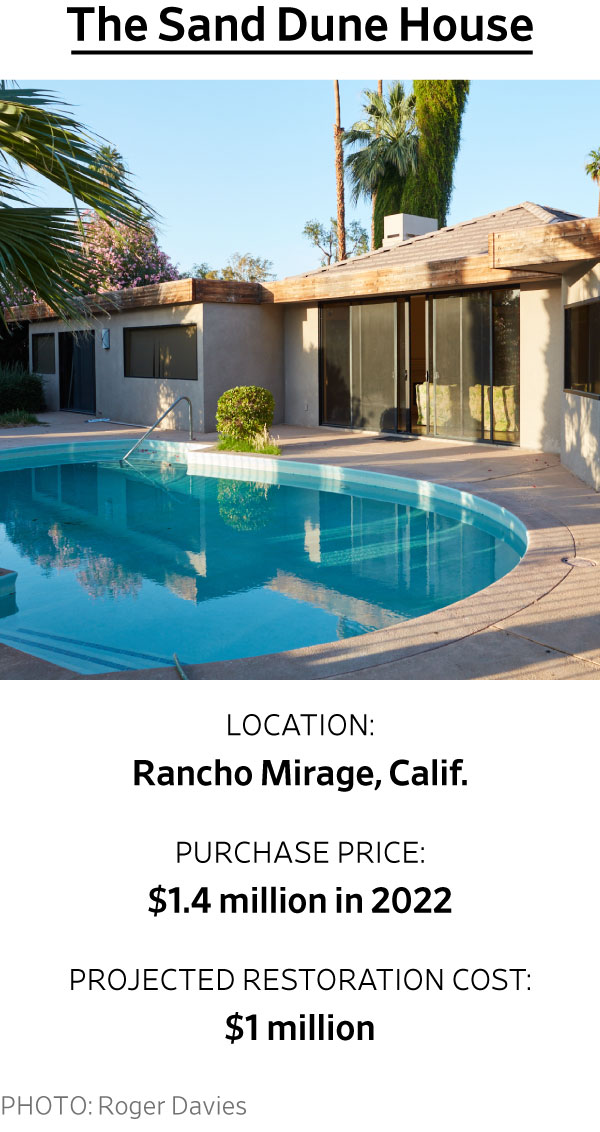
In 2021, McIlwee made a snap decision to buy a second house in Rancho Mirage, just down the street from the Ford Estate on Sand Dune Road. The move flew in the face of a conversation the couple had recently had about taking a step back from their renovation projects, which take up a lot of time and money.
The rationale? He was concerned that a developer would buy and ruin the house, a modest 1960s home that he believes was designed by the architect William Francis Cody.
“He was very anxious about it,” Damaschke said.
McIlwee chalked his anxiety up to the flipping frenzy that took over the Palm Springs and Rancho Mirage markets during the pandemic. Developers, he said, were buying houses, putting “maybe $100,000” into them, painting them white, adding a cactus and reselling. He found the bright white paint jobs especially abhorrent, preferring the traditional sand tones of desert houses.
“I wasn’t going to let that happen on my street,” he said.
At the time of the purchase, Damaschke said, he was in London and sick with Covid. “I didn’t really have a say in that one,” he said with a laugh. “He snuck it in under the radar.”
“I just said, ‘Sign this,’” McIlwee said.
They paid about $1.4 million for the three-bedroom house, which also sits on the golf course at Thunderbird. Spanning about 3,400 square feet, it has travertine floors and 16-foot sliding doors leading to the pool deck.
The house had undergone several “bad” renovations that have “glommed on to each other,” McIlwee said, and needs a lot of work. They plan on peeling back much of the block siding and basework and removing an addition that a previous owner put on the house. He estimated the cost at around $1 million.
McIlwee said they are unsure of their long-term plans for the property, but they might rent it out.
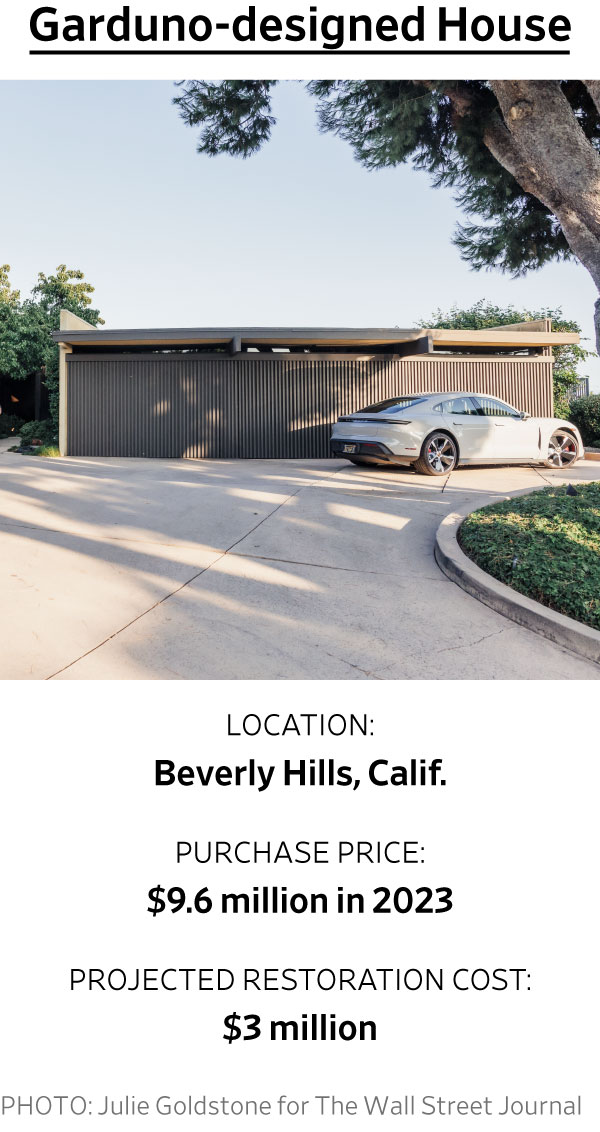
This year, the couple bought a four-bedroom Modernist house in Beverly Hills designed by the little-known Mexican architect Raul F. Garduno.
Located in the tony Trousdale enclave, the roughly 5,400-square-foot home was built in the early 1970s and has long, curving hallways, a step-down living room and a rounded swimming pool. Its design is unusual, Marmol said, because the various wings of the house seem to splay out from a single point like an off-centre windmill. The house also steps up as the site slopes down, so the house seems to respond directly to the shape of the earth.
McIlwee and Damaschke said they first saw the property when a friend who runs a design company rented it as a show house. “When Bill and I walked in, we were immediately like, ‘We’re going to get this house,’” McIlwee said.
At the time, the property was still owned by the same family it had been built for five decades prior. The original owner’s daughter, Lynne Corazza Anderson, had been fielding offers, McIlwee said, but most of the competitive ones had come from developers, who planned to tear down the house and replace it. Though he was aware of the proliferation of spec developments in the Trousdale neighbourhood, which has drawn celebrities like Jennifer Aniston and David Spade, McIlwee said he found the notion of tearing down the house “dumbfounding.” The couple decided to sell the Lautner house and use the capital to restore the Garduno house.
McIlwee convinced Anderson to hold off on accepting any of the offers for several months so that he and Damaschke had time to sell the Lautner house. Eventually they bought the Garduno house for $9.6 million in April. He estimated that they will spend at least another $3 million renovating it. They already have plans to redo the kitchen and bathrooms. They also intend to wall up some doors in the hallway to create an art corridor.
McIlwee said he also intends to amplify Garduno’s name.
“In every magazine right now, people are talking about Mexico City. Well, this is the perfect example of Mexican Modernism,” he said. “I’m taking it upon myself to give this guy some air.”
The house will be the couple’s new primary home; it is their first time living in the coveted 90210 ZIP Code. Two friends who came to lunch earlier this summer brought the couple a “Welcome to 90210” cake. “I’m still laughing about that,” McIlwee said.
 Copyright 2020, Dow Jones & Company, Inc. All Rights Reserved Worldwide. LEARN MORE
Copyright 2020, Dow Jones & Company, Inc. All Rights Reserved Worldwide. LEARN MORE
What a quarter-million dollars gets you in the western capital.
Alexandre de Betak and his wife are focusing on their most personal project yet.
As Paris makes its final preparations for the Olympic games, its residents are busy with their own—packing their suitcases, confirming their reservations, and getting out of town.
Worried about the hordes of crowds and overall chaos the Olympics could bring, Parisians are fleeing the city in droves and inundating resort cities around the country. Hotels and holiday rentals in some of France’s most popular vacation destinations—from the French Riviera in the south to the beaches of Normandy in the north—say they are expecting massive crowds this year in advance of the Olympics. The games will run from July 26-Aug. 1.
“It’s already a major holiday season for us, and beyond that, we have the Olympics,” says Stéphane Personeni, general manager of the Lily of the Valley hotel in Saint Tropez. “People began booking early this year.”
Personeni’s hotel typically has no issues filling its rooms each summer—by May of each year, the luxury hotel typically finds itself completely booked out for the months of July and August. But this year, the 53-room hotel began filling up for summer reservations in February.
“We told our regular guests that everything—hotels, apartments, villas—are going to be hard to find this summer,” Personeni says. His neighbours around Saint Tropez say they’re similarly booked up.
As of March, the online marketplace Gens de Confiance (“Trusted People”), saw a 50% increase in reservations from Parisians seeking vacation rentals outside the capital during the Olympics.
Already, August is a popular vacation time for the French. With a minimum of five weeks of vacation mandated by law, many decide to take the entire month off, renting out villas in beachside destinations for longer periods.
But beyond the typical August travel, the Olympics are having a real impact, says Bertille Marchal, a spokesperson for Gens de Confiance.
“We’ve seen nearly three times more reservations for the dates of the Olympics than the following two weeks,” Marchal says. “The increase is definitely linked to the Olympic Games.”

According to the site, the most sought-out vacation destinations are Morbihan and Loire-Atlantique, a seaside region in the northwest; le Var, a coastal area within the southeast of France along the Côte d’Azur; and the island of Corsica in the Mediterranean.
Meanwhile, the Olympics haven’t necessarily been a boon to foreign tourism in the country. Many tourists who might have otherwise come to France are avoiding it this year in favour of other European capitals. In Paris, demand for stays at high-end hotels has collapsed, with bookings down 50% in July compared to last year, according to UMIH Prestige, which represents hotels charging at least €800 ($865) a night for rooms.
Earlier this year, high-end restaurants and concierges said the Olympics might even be an opportunity to score a hard-get-seat at the city’s fine dining.
In the Occitanie region in southwest France, the overall number of reservations this summer hasn’t changed much from last year, says Vincent Gare, president of the regional tourism committee there.
“But looking further at the numbers, we do see an increase in the clientele coming from the Paris region,” Gare told Le Figaro, noting that the increase in reservations has fallen directly on the dates of the Olympic games.
Michel Barré, a retiree living in Paris’s Le Marais neighbourhood, is one of those opting for the beach rather than the opening ceremony. In January, he booked a stay in Normandy for two weeks.
“Even though it’s a major European capital, Paris is still a small city—it’s a massive effort to host all of these events,” Barré says. “The Olympics are going to be a mess.”
More than anything, he just wants some calm after an event-filled summer in Paris, which just before the Olympics experienced the drama of a snap election called by Macron.
“It’s been a hectic summer here,” he says.
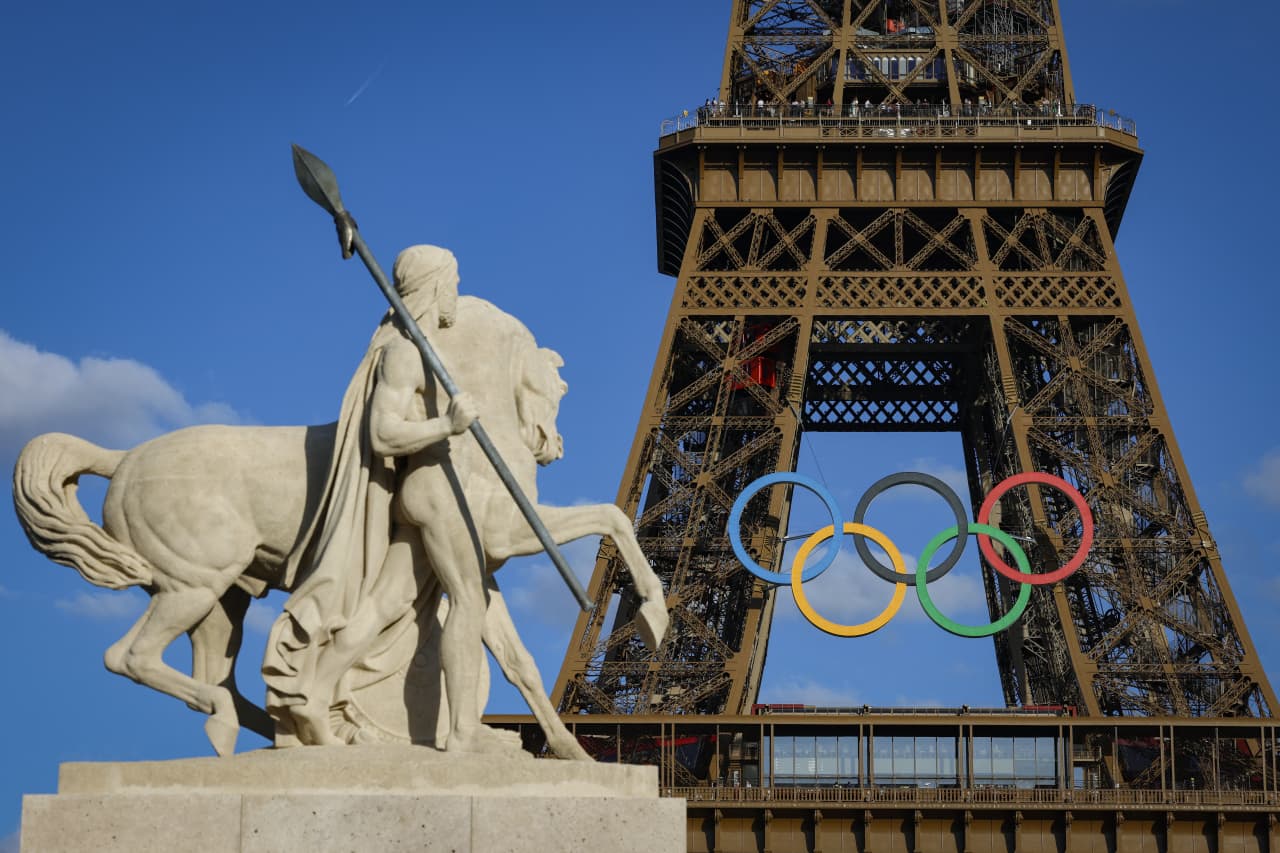
Parisians—Barré included—feel that the city, by over-catering to its tourists, is driving out many residents.
Parts of the Seine—usually one of the most popular summertime hangout spots —have been closed off for weeks as the city installs bleachers and Olympics signage. In certain neighbourhoods, residents will need to scan a QR code with police to access their own apartments. And from the Olympics to Sept. 8, Paris is nearly doubling the price of transit tickets from €2.15 to €4 per ride.
The city’s clear willingness to capitalise on its tourists has motivated some residents to do the same. In March, the number of active Airbnb listings in Paris reached an all-time high as hosts rushed to list their apartments. Listings grew 40% from the same time last year, according to the company.
With their regular clients taking off, Parisian restaurants and merchants are complaining that business is down.
“Are there any Parisians left in Paris?” Alaine Fontaine, president of the restaurant industry association, told the radio station Franceinfo on Sunday. “For the last three weeks, there haven’t been any here.”
Still, for all the talk of those leaving, there are plenty who have decided to stick around.
Jay Swanson, an American expat and YouTuber, can’t imagine leaving during the Olympics—he secured his tickets to see ping pong and volleyball last year. He’s also less concerned about the crowds and road closures than others, having just put together a series of videos explaining how to navigate Paris during the games.
“It’s been 100 years since the Games came to Paris; when else will we get a chance to host the world like this?” Swanson says. “So many Parisians are leaving and tourism is down, so not only will it be quiet but the only people left will be here for a party.”